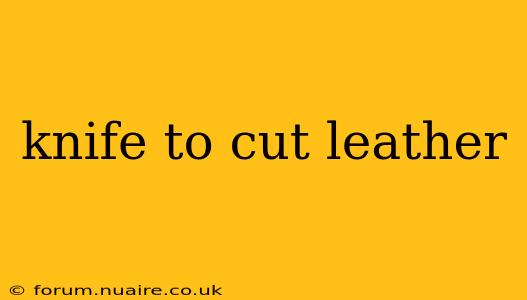Cutting leather requires a specialized knife; a standard kitchen knife just won't do. The right tool makes all the difference, ensuring clean cuts, preventing damage to your material, and promoting longevity in your craft. This comprehensive guide will help you navigate the world of leather-cutting knives, addressing common questions and concerns along the way.
What Kind of Knife Do You Use to Cut Leather?
This depends heavily on the type of leather, the project's intricacy, and your personal preference. However, several knife types consistently excel at leather work:
- Rotary Cutters: Excellent for straight cuts and repetitive tasks, offering speed and precision. They're ideal for cutting out large quantities of identical shapes.
- Swivel Knives: Provide exceptional control for intricate designs and curved cuts. They're a favorite among leatherworkers who create detailed projects.
- Utility Knives: Versatile and affordable, these are a great starting point for beginners. The replaceable blades allow for maintaining a sharp edge, crucial for clean leather cuts.
- Craft Knives: Often featuring smaller, more specialized blades, craft knives offer precision for smaller, more delicate projects.
What is the Best Blade for Cutting Leather?
The best blade for cutting leather is sharp, durable, and appropriate for the task. Generally, blades with a fine point and a sharp edge are preferred. The material of the blade also matters. High-carbon steel blades are known for their strength and sharpness retention.
Can You Use an Exacto Knife to Cut Leather?
Yes, an Exacto knife (or similar craft knife) can be used to cut leather, but it's generally best suited for lighter leathers and smaller, more intricate projects. For thicker or tougher leathers, a more robust knife like a utility knife or a swivel knife is recommended. The small blade size on an Exacto knife can lead to more effort and potential for uneven cuts on thicker materials.
What is the Sharpest Knife for Cutting Leather?
Sharpness is paramount. A dull knife will tear and damage the leather, leading to uneven edges and frustrating results. While a specific "sharpest" knife is subjective and depends on maintenance, high-carbon steel blades, properly sharpened, will consistently provide the sharpest cutting edge. Regular honing and sharpening are essential to maintaining this sharpness.
How Do You Cut Leather Without Ripping It?
Preventing rips is crucial. Here are some key techniques:
- Sharp Blade: This is the most important factor. A dull blade will always tear leather.
- Proper Technique: Use a smooth, controlled cutting motion, avoiding jerky movements. Let the weight of the knife do the work.
- Cutting Mat: A self-healing cutting mat protects both your blade and your work surface, providing a stable base for cutting.
- Leather Type: Understand the characteristics of your leather. Thicker, stiffer leathers may require more force and potentially a different knife.
What's the Best Tool for Cutting Thick Leather?
For thick leather, a strong, sharp blade is a must. A utility knife with a fresh blade or a specialized leather cutting knife designed for heavy-duty work is recommended. Consider using a combination of tools; perhaps scoring the leather initially with a scoring wheel before making the final cut.
By understanding the nuances of different knives and techniques, you'll be well-equipped to tackle any leather-cutting project with confidence. Remember, a sharp blade and a steady hand are your best allies in creating beautiful and durable leather goods.

